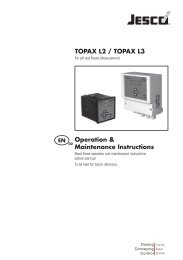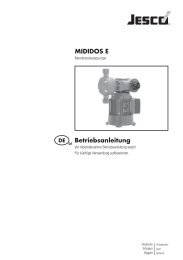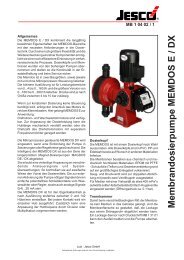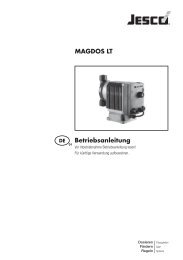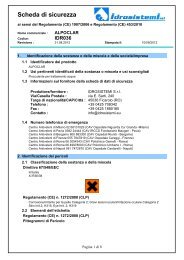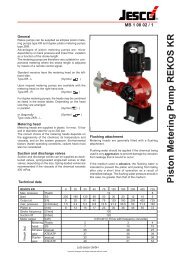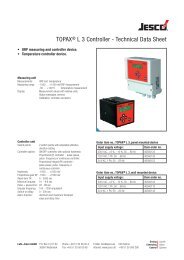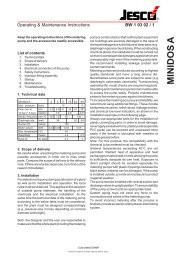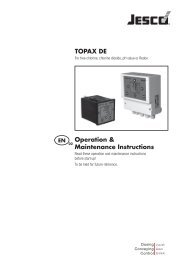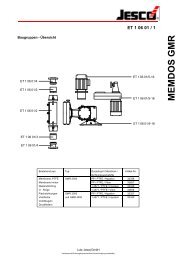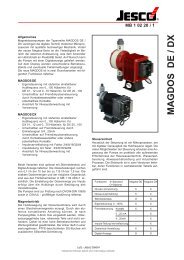Create successful ePaper yourself
Turn your PDF publications into a flip-book with our unique Google optimized e-Paper software.
<strong>Solenoid</strong>-<strong>Diaphragm</strong> <strong>Dosing</strong> <strong>Pump</strong> MAGDOS LP<br />
Operating Instructions<br />
2 Safety<br />
2.1 General warnings<br />
The following warnings are intended to help you to eliminate the<br />
dangers that can arise while handling the dosing pump. Risk prevention<br />
measures always apply regardless of any specific action.<br />
Safety instructions warning against risks arising from specific activities<br />
or situations can be found in the respective sub-chapters.<br />
DANGER<br />
Danger to life due to electric shock<br />
Wrongly connected or located cables or damaged ones can injure<br />
you.<br />
Connect the device only to a socket outlet with earthing contact<br />
protected by a ground fault circuit interrupter (GFCI).<br />
Replace damaged cables without delay.<br />
Do not use extension cables.<br />
Do not bury cables.<br />
Secure cables to avoid being damaged by other equipment.<br />
DANGER<br />
Danger to life through explosions!<br />
When using dosing pumps without ATEX certification in a potentially<br />
explosive area, explosions can occur that result in fatal injuries.<br />
Never use the MAGDOS LP dosing pump in potentially explosive<br />
areas.<br />
WARNING<br />
Caustic burns or other burns through dosing media!<br />
After connecting the mains supply, residual dosing media in the<br />
dosing head can spray out.<br />
Before connecting the mains supply, connect the dosing lines.<br />
Check that all the screw connections have been tightened correctly<br />
and are leak-proof.<br />
WARNING<br />
Caustic burns or other burns through dosing media!<br />
While working on the dosing head, valves and connections, you may<br />
come into contact with dosing media.<br />
Use sufficient personal protective equipment.<br />
Rinse the dosing pump with a liquid (e.g. water) which does not<br />
pose any risk. Ensure that the liquid is compatible with the<br />
dosing medium.<br />
Release pressure in hydraulic parts.<br />
Never look into open ends of plugged pipelines and valves.<br />
WARNING<br />
Caustic burns or other burns through dosing media!<br />
The materials of the dosing pump and hydraulic parts of the system<br />
must be suitable for the dosing medium that is used. Should this not<br />
be the case, the dosing media may leak.<br />
Make sure that the materials you are using are suitable for the<br />
dosing medium.<br />
Make sure that the lubricants, adhesives, sealants, etc. that you<br />
use are suitable for the dosing medium.<br />
CAUTION<br />
Increased risk of accidents due to insufficient qualification<br />
of personnel!<br />
<strong>Dosing</strong> pumps and their accessories may only be installed, operated<br />
and maintained by personnel with sufficient qualifications. Insufficient<br />
qualification will raise the risk of accidents.<br />
Ensure that all action is taken only by personnel with sufficient<br />
and corresponding qualifications.<br />
Prevent access to the system for unauthorised persons.<br />
CAUTION<br />
Danger of personal injury and material damage!<br />
Changing dosing media can lead to unpredictable reactions.<br />
Thoroughly clean the dosing pump and appropriate sections of<br />
the plant to avoid chemical reactions.<br />
© Lutz-Jesco GmbH 2012<br />
Subject to technical changes.<br />
BA-10231-02-V01<br />
Safety<br />
General warnings<br />
5



